Social Isolation - the Effects on Elderly's Development.
> Clarafong
Social Isolation Among Older Individuals: The Relationship to Mortality and Morbidity - The Second Fifty Years - NCBI Bookshelf. Society of Certified Senior Advisors: Social Isolation and Loneliness in Older Adults. What is Loneliness and Social Isolation?
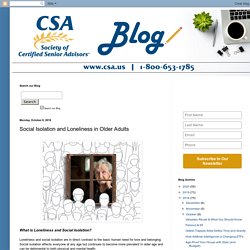
Loneliness and social isolation are in direct contrast to the basic human need for love and belonging. Social isolation effects everyone at any age but continues to become more prevalent in older age and can be detrimental to both physical and mental health. All over the globe, social isolation rates continue to increase, particularly in older adults. According to a recent AARP report, social isolation and loneliness is present in more than 8 million people in America over the age of 50. According to the study, 35% of respondents said they were isolated and 45% responded they were lonely for 6 or more years (AARP, 2017). Loneliness and social isolation is complex to say the least. Some of the most staggering data indicates that loneliness was as robust predictor of early death as alcoholism, smoking 15 cigarettes a day, and stronger predictor than obesity or a sedentary lifestyle.
Untitled. Untitled. Causes of Social Isolation in Elderly Adults. No one likes to feel lonely or isolated, but for many seniors, it’s a feeling they know all too well.
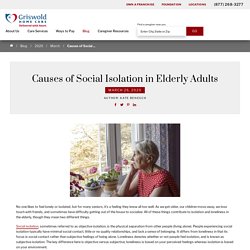
As we get older, our children move away, we lose touch with friends, and sometimes have difficulty getting out of the house to socialize.
Aging & Isolation — Causes and Impacts. January/February 2017 Issue Aging & Isolation — Causes and Impacts By Lauren Snedeker, LMSW Social Work Today Vol. 17 No. 1 P. 24 Many older adults experience aging as a positive time because they remain active and connected to others, but many other elders become disconnected from family, friends, and community.

This article examines the causes and results of isolation and how social workers can help reduce its impact. Older adults comprise the fastest growing segment of the population, with some 10,000 baby boomers turning 65 every day, a rate the U.S. Census Bureau estimates will continue until the year 2030.
Stunning Facts About Senior Isolation. Nearly one-third of all seniors live by themselves, according to the U.S.

Census Bureau. That’s close to 13.8 million seniors aging alone. Senior isolation is both common and dangerous — and while living alone doesn’t inevitably lead to senior loneliness, the two often go hand-in-hand.
Coronavirus: Elderly hit hard by social isolation amid circuit breaker measures, Health News. A needle and the television set - these two objects have been keeping 83-year-old Nellie Woo company from morning to night for the past week while she is holed up alone at home. She used to enjoy playing bingo and exercising with her elderly neighbours at the Senior Activity Centre (SAC) downstairs, as well as chatting with volunteers who visited her studio flat.
Now that all activities for seniors - including home visits - have ceased due to strict circuit breaker measures, Madam Woo is feeling lonely and emotionally down. She thinks about suicide sometimes, and has spent so much time staring at her patchwork and TV lately that her doctor had to give her antibiotics for dry eyes. For such elderly people, the ills that come with social isolation pose a significant health risk, say some seniors and social workers. Out of the 208,000 people who live alone in Singapore, at least a quarter of them are elderly. In 2016, there were 47,000 seniors aged 65 and above who lived by themselves.
Social isolation, loneliness in older people pose health risks. Human beings are social creatures.
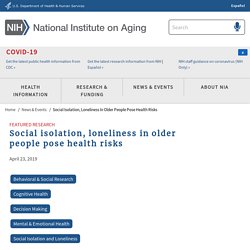
Our connection to others enables us to survive and thrive. Yet, as we age, many of us are alone more often than when we were younger, leaving us vulnerable to social isolation and loneliness—and related health problems such as cognitive decline, depression, and heart disease. Fortunately, there are ways to counteract these negative effects.
Untitled. Loneliness and Social Isolation Linked to Serious Health Conditions. Social isolation was associated with about a 50% increased risk of dementia and other serious medical conditions.
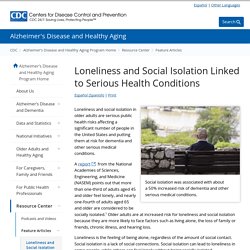
The loneliness of social isolation can affect your brain and raise dementia risk in older adults. Physical pain is unpleasant, yet it’s vital for survival because it’s a warning that your body is in danger.
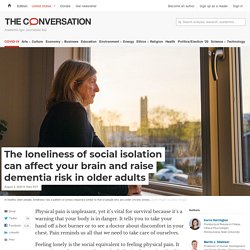
It tells you to take your hand off a hot burner or to see a doctor about discomfort in your chest. Pain reminds us all that we need to take care of ourselves. Feeling lonely is the social equivalent to feeling physical pain. It even triggers the same pathways in the brain that are involved in processing emotional responses to physical pain. Just like feeling physical pain, feeling lonely and disconnected from others is also a signal that we need to take care of ourselves by seeking the safety and comfort of companionship. As scholars at the Center for Healthy Aging at Penn State, we study the impact of stress on the aging body and brain, including how it can worsen cognitive decline and risk for dementia.
The health consequences of loneliness. Schematic representation of socially isolated brain A Anatomy of the isolated human. How to Combat Loneliness and Isolation as We Age. Addressing Social Isolation Among Seniors. Cohousing communities help prevent social isolation. Social Isolation in Older Adults.







